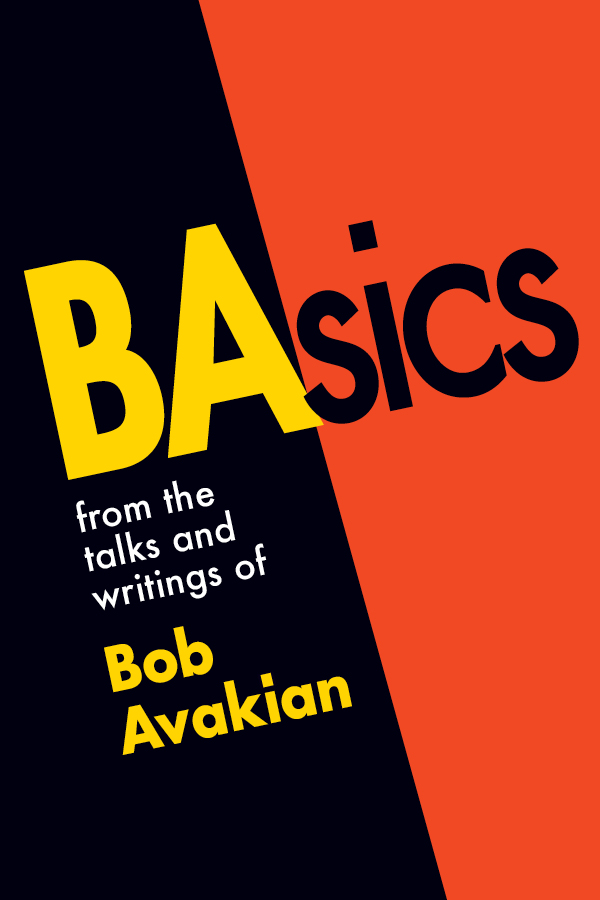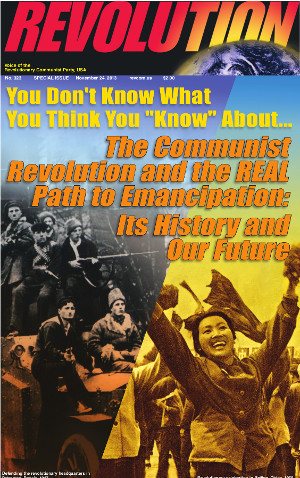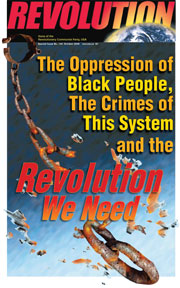November 21, 2015
Stanford Students Sit In, Demand University Divest from All Fossil Fuels
by Larry Everest | November 23, 2015 | Revolution Newspaper | revcom.us
An important struggle took place at Stanford University in the San Francisco Bay Area this past week, pointing to both the growing wave of campus activism and real challenges facing the movement for revolution.
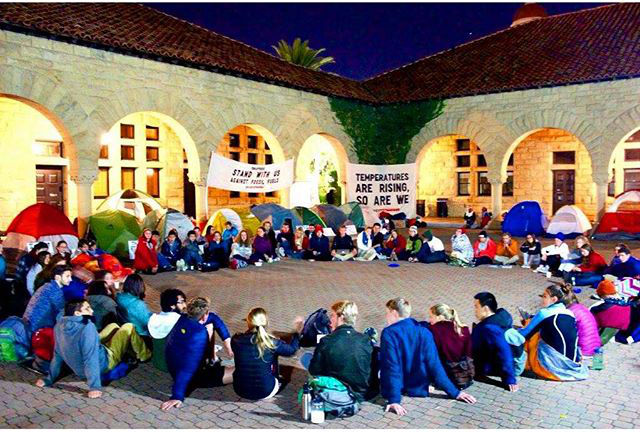
Students at Stanford University camped out all week demanding that Stanford divest
from all fossil fuels. (Photo: Fossil Free Stanford website)
Starting Monday night, November 16, some 100 students staged a sit-in/encampment outside the office of university president John Hennessy demanding that Stanford, which has an endowment of over $20 billion, divest from all fossil fuels. They camped out all week, defying university threats and drawing very broad support on campus and beyond. They ended their sit-in on Friday after meeting with the president, during which he agreed to bring their demands to the Board of Trustees. There has not been an action like this at Stanford, an elite private university, in many years.
The encampment, which grew out of an ongoing divestment campaign—“Fossil Free Stanford”—began on Monday when some 100 students gathered in front of the administration building and demanded to talk with Hennessy. When they were instead blocked by university police, they decided to sit in. That day another 300 students joined them to march and rally.
“A Very, Very Dramatic Move to Make”
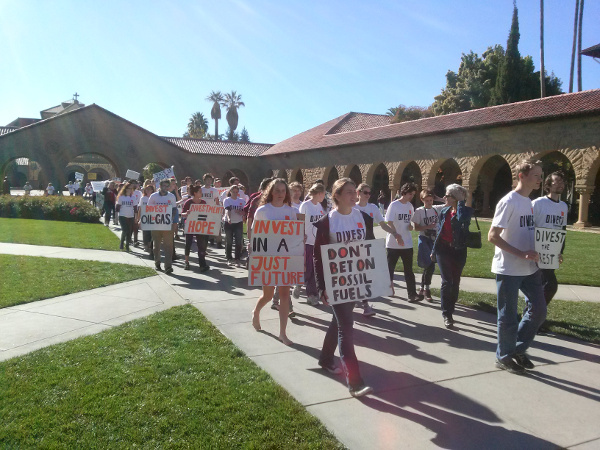

Stanford University sit-in and call demanding university divestment from fossil fuels. (Photos: Revolution/revcom.us)
I talked with two of the student organizers on Thursday about the encampment and their own involvement.
One, a freshman, described two “turning points” that spurred him and others to sit in. First, he’d been “very excited” about the Board of Trustees’ May 2014 decision to divest from businesses using coal, but that “was overshadowed by the fact that when we pulled out of coal, the largest two investments were made in the oil and gas industry. So then our ‘ask’ has changed to full divestment from fossil fuels.” The other “huge takeaway from the meeting with Hennessy was that they were comfortable investing in fossil fuels because they were comfortable burning them in their cars. That hurt us a lot because we’re so passionate about the environment.”
The students described what a big step sitting in at Stanford has been for them and other students. “This is a very, very drastic move to take. Camping outside the president’s office is a very controversial move, but we feel we’ve explored every avenue we can and have nowhere else to go,” the freshman said.
The other student, a junior, put it this way: “Stanford is full of very high-functioning people who’ve gotten to where they are by following the rules and doing things right in their own lives, and it’s worked so far. So I think this action is huge in taking us, who have gone about making change and achieving in a very structured way, and pushing us a bit.”
Another student told the Stanford Daily, “[F]or the first time, I’m not just doing what I’m told but doing what I think is right.”
Resisting University Threats
Tuesday morning the students received a letter from the university administration warning them that their encampment violated university rules and the student “code of conduct” by impeding business in the Administration Building. The students disagreed, and instead sent an open letter to Hennessy and the Board of Trustees turning the language and framework of the warning letter into an indictment:
“In order to comply with Stanford University’s mission and Fundamental Standard, you must immediately divest from the rest of the fossil fuel industry. The student body and Stanford community are instructing you to do so,” the students wrote. Pointing to the environmental implications of refusing to divest, the students asked, “Can you accept the consequences of your own inaction?” They told the university administration that they would not move the encampment: “This movement is not going away.”
The administration also warned students that they had until 5 pm Friday, November 20, to end their encampment or face possible trespassing charges. The students again refused (and we saw that many had the phone number for legal help in case of arrest marked on their arms).
Sparking Broader Support and Engagement
Before the sit-in, support had been building for divestment from fossil fuels. According to Fossil Free Stanford:
“Over 239 Stanford students and faculty have pledged to engage in direct action unless the University divests from oil and gas; More than 3,200 students, faculty, alumni, and community members have expressed support for the cause; Last year, 75% of the Stanford undergraduate student body voted in favor of fossil fuel divestment; More than 379 Stanford faculty have co-signed a letter calling on the administration to divest; The Associated Students of Stanford University (ASSU), representing the undergraduate population, and the Graduate Student Council have both passed resolutions in support of fossil fuel divestment.”
The encampment of inflatable air mattresses and tents pitched in the corner of the main Quad, outside the administration building, became a focal point sparking broader involvement and debate. Some protesters stopped attending classes at all, many with support from their professors. The Stanford Daily reported that during the week, there had been 30 teach-ins and more than a dozen relocated classes, including Antigone and Social Dissent, Politics and Justice in Carbon Accounting, and Black Lives Matter and Student Activism.
The student organizers told us the Stanford Collaborative Orchestra had performed their work “El Niño,” a compilation of Handel’s Water Music suites, and that following a performance in Memorial Church (across the Quad from the encampment), the Stanford Choir had come over and done a performance for them. Many campus groups and organizations had come and written statements of support. There had been near-daily rallies. When we were there, some 125 students rallied along with 20-30 alums (who stated they wouldn’t donate to Stanford until it divests). While we were talking to the organizers, a tour group of high school students led by a Stanford student walked by. They stopped and loudly chanted: “What do we want? Climate justice! When do we want it? Now!” There were students clustered in small groups talking, hanging out, or sitting alone doing homework.
The encampment organizers were also supporting other actions on campus such as Tuesday’s rally “to uplift Muslim and Arab voices in the wake of Islamophobia following the Paris attacks,” and Wednesday’s #StudentBlackout rally supporting students protesting racism at campuses across the country.
The global impact of the environmental crisis was represented in an installation/art project near the encampment. It aims to “shine a spotlight on the high profile cases of global communities that have been directly affected by the negligence of the fossil fuel industry,” an involved student told the Stanford Daily. The piece focuses on Chevron’s oil spill in Ecuador, sea-level rise in Tuvalu, and the California drought. “[The project] really brings the moral issue to the absolute forefront,” she said.
Upsurge in Campus Protest & Activism
When I’d been on the Stanford campus several years ago, in the aftermath of the Occupy protests, a student told me that the only thing that drew crowds of students were networking meetings to develop new apps and the like. But there has been a definite upswing in campus protests and activism over the past couple of years. A number of the students we talked with said it was their first protest ever, so I asked the student organizers about that.
They cited several things. First, according to the junior, there was a “feeling of momentum on campus, that activism is OK, that it’s exciting, it’s necessary. This was unheard of for a long time here and this sit-in would never have happened five years ago. When Stanford divested from coal, people looked around and said, ‘I’m not the only one that cares.’ There’s a narrative that we are winning, even though it doesn’t seem like it most of the time. I could get behind that.
“Then there was Ferguson, the Stanford 68 [students arrested this past January for blocking the San Mateo Bridge], and organizing around Black Lives Matter. There’s a growing sense of urgency about the world outside of Stanford. Stanford is so insulated, so comfortable, the pull of complacency is so strong. It’s nice to have a great day here, but so many others are living in a very different reality and we can’t let that go by.”
The freshman added, “Very recently, one of the reasons [for rising activism] is the sheer number of events going on in the world right now: Black Lives Matter, LGBT issues, and so much else going on right now it’s impossible to ignore. There’s a rally every other day in White Plaza [at the center of campus], and people are starting to feel there’s change coming in our community and its coming very, very quickly and their hopping on board.”
Other students told us they’d been moved to take a stand by the growing climate emergency. One joined when he’d “overcome the inertia of feeling there’s nothing you can do at Stanford, that it would never divest.”
Big Openings, and Challenges for Revolutionaries

This Revolution special issue focuses on the environmental emergency that now faces humanity and Earth’s ecosystems. In this issue we show:
- the dimensions of the emergency...
- the source of its causes in the capitalist system, and the impossibility of that system solving this crisis...
- a way out and way forward for humanity—a revolutionary society in which we could actually live as custodians of nature, rather than as its plunderers.
Read online....
Also available in brochure format (downloadable PDF)
So there’s something new developing on the Stanford campus (and others!) in relation to key issues of the day. There’s a real awakening and a real moral dimension of students refusing to simply “do what they’re told,” but instead getting out of their comfort zones and taking a stand for what they see as right. This is very important.
At the same time, their understanding of the problem and the solution is, at the moment, confined within the system’s boundaries. We caught discussion of personal responsibility and consumerism as being key; about climate change being a social justice issue, and “the intersectionality of environmental degradation, ethnicity and class;” about “change systems of power and the power dynamics on campus.”
One of the students responded to my question about revolution and communism like this: “It’s difficult to convince people on communism so at some point we may have to accept capitalism is inevitable and we have to work within that, making clean energy cheaper and more available, and work through our government. There’s a growing acceptance that ‘radical’ isn’t such a bad thing, and as things change more people will be receptive to that. But maybe we can’t get rid of capitalism but we can erode its worst aspects. Any talk of revolution right now is not politically feasible, but then we’re doing our own revolution here on campus.”
My sense was that these students aren’t locked in position or firmly wedded to other trends, so much as questions of capitalism, revolution and communism have been off their radar, very few seemed to have seriously engaged deeper questions like the nature of capitalism, can it solve the environmental catastrophe, or will it take revolution and an entirely different economic and political system to do that.
At the same time, we found real openness and curiosity. People were interested in our materials (including “ATerrorist Attack in Paris, a World of Horrors, and the NEED FOR ANOTHER WAY”and “Which Side Are You On? STATEMENT OF SUPPORT FOR UNIVERSITY OF MISSOURI STUDENTS FROM CARL DIX,” and many were glad we’d come down. A number said that there should be more discussion of alternatives to the current system.
One of the student organizers told me, “McCarthy did a great job of making communism and socialism dirty words, and I think that sucks because it means it’s not a political reality for a lot of people to make alternatives to capitalism a part of their rhetoric.”
When I suggested I do a teach-in on the climate crisis, revolution, and BA’s new synthesis, the freshman I was talking with said with real enthusiasm: “That would be great!”
“We’ll Escalate and Take Direct Action till University Divests Fully from Fossil Fuels”
Student organizers don’t expect the Board of Trustees to grant their demands, and say their struggle for full divestment from fossil fuels is far from over. One organizer said students left the Friday meeting with Hennessy “determined and hopeful, but also very frustrated and not very proud of our university... But we are very proud of our students.” One of their goals, he said, was “to declare that the student body will not be complicit with fossil fuel investment.”
Another told the Stanford Daily that although the sit-in was over, Fossil Free Stanford “will continue to escalate and take direct action until the university divests fully from fossil fuels.”
Volunteers Needed... for revcom.us and Revolution
If you like this article, subscribe, donate to and sustain Revolution newspaper.



